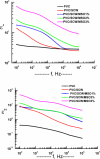Preparation of antimicrobial polymeric composites using defective silk cocoons and moringa seed oil as additives for polyvinyl chloride
- PMID: 40325099
- PMCID: PMC12053577
- DOI: 10.1038/s41598-025-97540-z
Preparation of antimicrobial polymeric composites using defective silk cocoons and moringa seed oil as additives for polyvinyl chloride
Abstract
In this work, novel polymeric blends were prepared from polyvinyl chloride (PVC) and silkworm cocoon waste (SCW), that were defective cocoons excluded during the silk-making process in the ratio 50:50 w/w. These blends were incorporated with moringa seed oil (MSO) as a bio-based plasticizer with different concentrations (1, 2, and 3%) to obtain a final bioplastic with superior antimicrobial properties. The new composites are characterized through Scanning Electron Microscope (SEM), Fourier Transmission Infrared Spectroscopy (FTIR), contact angle measurements, Thermogravimetric analysis (TGA), dielectric, mechanical, and antimicrobial properties. Results of the study pointed to improved linking between the blend phases after incorporating 2% MSO. The composites could inhibit the growth of all the tested microorganisms. The conductivity σdc values increased by increasing the content of MSO in the composite. The results demonstrate the potential of the new MSO plasticized composites as promising candidates for use in hospitals as antimicrobial surfaces.
Keywords: Antimicrobial; Bio-based plasticizer; Dielectric; PVC composites; Silk cocoons.
© 2025. The Author(s).
Conflict of interest statement
Declarations. Competing interests: The authors declare no competing interests.
Figures









Similar articles
-
Antimicrobial surface functionalization of PVC by a guanidine based antimicrobial polymer.Mater Sci Eng C Mater Biol Appl. 2016 Oct 1;67:214-220. doi: 10.1016/j.msec.2016.05.052. Epub 2016 May 13. Mater Sci Eng C Mater Biol Appl. 2016. PMID: 27287116 No abstract available.
-
Novel nano composites from Citrus limon and Citrullus colocynthis agricultural wastes for biomedical applications.Sci Rep. 2024 Jul 28;14(1):17343. doi: 10.1038/s41598-024-67423-w. Sci Rep. 2024. PMID: 39069554 Free PMC article.
-
Comparing the microstructure and mechanical properties of Bombyx mori and Antheraea pernyi cocoon composites.Acta Biomater. 2017 Jan 1;47:60-70. doi: 10.1016/j.actbio.2016.09.042. Epub 2016 Sep 30. Acta Biomater. 2017. PMID: 27693687
-
Antimicrobial components in the cocoon silk of silkworm, Bombyx mori.Int J Biol Macromol. 2023 Jan 1;224:68-78. doi: 10.1016/j.ijbiomac.2022.10.103. Epub 2022 Oct 14. Int J Biol Macromol. 2023. PMID: 36252626 Review.
-
Silkworm silk-based materials and devices generated using bio-nanotechnology.Chem Soc Rev. 2018 Aug 28;47(17):6486-6504. doi: 10.1039/c8cs00187a. Chem Soc Rev. 2018. PMID: 29938722 Free PMC article. Review.
References
-
- Lieberzeit, P., Bekchanov, D. & Mukhamediev, M. Polyvinyl chloride modifications, properties, and applications. Polym. Adv. Technol.33(6), 1809–1820 (2022).
-
- Pyrek, K. M., Hospital privacy curtains and bed sheets: Soft surface contamination and transmission.
-
- Sin, M. C. et al. Viscoelastic, spectroscopic, and microscopic characterization of novel bio-based plasticized poly (vinyl chloride) compound. Int. J. Polym. Sci.2014, 846189 (2014).
MeSH terms
Substances
LinkOut - more resources
Full Text Sources

